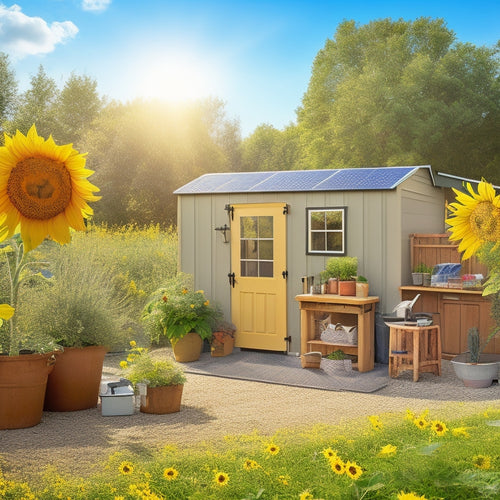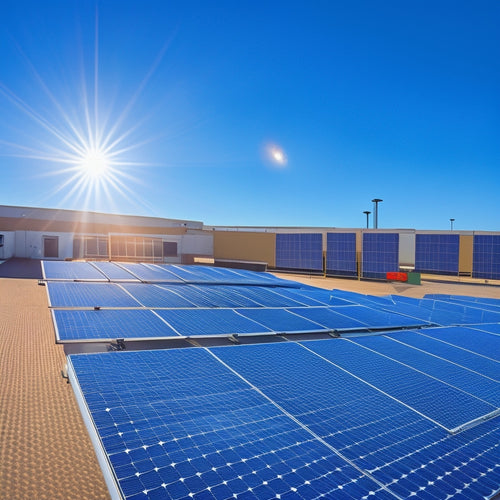
Cost for Installing Solar Panels at Home
Share
You can expect to pay between $15,000 and $30,000 to install solar panels at your home, although the actual cost will depend on factors like your energy usage, roof size, and local incentives. The federal government offers a 26% tax credit, and various state and local incentives can also help offset the initial installation cost. Additionally, solar panels can increase your property value by an average of $15,000 and lead to significant long-term savings on energy bills. With the right installation, you can achieve energy independence and start generating clean power - and there's more to investigate when it comes to maximizing your solar investment.
The Essentials
- The federal government offers a 26% tax credit of the total cost of solar panel installation, requiring documentation and receipts for claiming.
- State and local incentives, such as property tax exemptions and performance-based incentives, can further reduce installation costs.
- Upfront rebates or grants can offset initial installation costs, and understanding these incentives is crucial for maximizing benefits.
- The Solar Investment Tax Credit (ITC) allows homeowners to claim a percentage of solar installation costs on federal taxes, with eligibility requiring installation before December 31, 2023.
- Accurate measurement of roof dimensions and characteristics, including size, orientation, and pitch, is essential for effective panel placement and installation feasibility.
Renewable Energy Tax Credits
When you install solar panels at home, you're eligible for solar panel incentives that can greatly reduce the upfront cost.
By switching to renewable energy solutions, you'll not only reduce your energy bills but also contribute to a sustainable future Renewable Energy Bundles.
The federal government offers a tax credit of 26% of the total installation cost, which you can claim on your taxes.
You'll need to keep receipts and documentation to claim this credit, so be sure to save them for your records.
Solar Panel Incentives
In conjunction with state and local governments, the federal government offers various incentives to encourage homeowners to invest in solar energy, chief among them being the Renewable Energy Tax Credit, also known as the Solar Investment Tax Credit (ITC).
As you consider installing solar panels at home, it's crucial to understand the solar incentives overview and how you can benefit from them. By incorporating home battery storage solutions, you can maximize your energy independence and reduce your reliance on the grid during power outages, ensuring that your essential appliances and lighting remain on even when the rest of the neighborhood is in the dark.
Additionally, you can also lower your electricity bills by storing excess energy generated by your solar panels.
You'll find that local rebates and incentives vary by state, county, or even city. These can include property tax exemptions, sales tax exemptions, and rebates on installation costs.
Some states offer performance-based incentives, where you're paid for the electricity generated by your solar panels. Others provide upfront rebates or grants to offset the initial cost of installation.
You may also be eligible for net metering, which allows you to sell excess energy back to the grid and offset your utility bills.
Federal Tax Credits
You've likely heard about the Renewable Energy Tax Credit, also known as the Solar Investment Tax Credit (ITC), which is a key federal incentive for homeowners investing in solar energy. This tax credit allows you to claim a percentage of the total cost of your solar panel installation against your federal income taxes.
By embracing a cleaner, more sustainable future with solar power and battery storage solutions, homeowners can't only reduce their electricity bills but also contribute to a healthier environment Renewable Energy Solutions. Currently, the ITC offers a tax credit of 26% of the total cost of your solar panel system, including equipment and installation.
To qualify for tax credit eligibility, your solar panel system must be installed and generating electricity before December 31, 2023. Additionally, you must own the solar panel system and have it installed on your primary or secondary residence in the United States.
You'll need to file Form 5695 with your taxes to claim the credit. The filing process typically involves calculating the total cost of your solar panel system, determining the applicable tax credit amount, and claiming it on your tax return.
Be certain to keep detailed records of your installation costs and system specifications to guarantee a smooth filing process.
Zero Energy Bills Possible
By installing solar panels at home, you'll start saving money immediately, as the electricity generated will offset your energy consumption.
With a well-designed system, you can assure energy independence, relying less on the grid and reducing your reliance on fossil fuels.
By utilizing renewable energy from photovoltaic cells, you'll be contributing to a more sustainable future.
Furthermore, a well-installed roof installation can guarantee maximum energy efficiency.
As a result, you'll enjoy zero energy bills, freeing up your budget for other priorities.
Save Money Now
Take control of your energy expenses and start generating your own clean power with solar panels, effectively slashing your utility bills to zero.
With the right installation, you can enjoy significant savings on your energy costs. The initial installation costs may seem intimidating, but with financing options available, you can spread the expense over time.
For example, you can opt for a solar loan or a power purchase agreement, which allows you to pay for the electricity generated rather than the upfront cost of the system.
Energy Independence Guaranteed
Your home's energy independence is within reach, and it's achievable through a well-designed solar panel system. With solar panels, you can generate your own clean energy, reducing your reliance on the grid and enjoying zero energy bills. This means you'll have more control over your energy costs and usage, living a more sustainable lifestyle.
Here's a breakdown of how solar panels can help you achieve energy autonomy:
| Benefits | Description | Results |
|---|---|---|
| Renewable Energy | Solar panels capture energy from the sun | Zero carbon emissions |
| Energy Self-Sufficiency | Generate your own energy on-site | Reduced reliance on the grid |
| Lower Energy Bills | Solar power reduces your energy costs | Increased savings |
| Increased Property Value | Solar panels enhance your property's value | Higher resale value |
Micro-Inverters Boost Efficiency
You'll get more energy out of your solar panels with micro-inverters, which optimize energy harvest at the individual panel level.
By doing so, micro-inverters improve panel performance by reducing the impact of shading, debris, or mismatched panels on overall system efficiency.
In addition, homes with solar battery storage can further increase their energy independence.
This results in increased energy production and a faster return on your solar investment.
Increased Energy Harvest
Micro-inverters play an essential role in optimizing energy harvest from solar panels, particularly in residential installations.
They're designed to convert DC power from each individual panel to AC power, which is then fed into your home's electrical grid. This setup allows you to maximize energy efficiency, as each panel operates independently.
In a traditional string inverter system, a single shaded or underperforming panel can reduce energy output from the entire array. Micro-inverters eliminate this issue, ensuring that each panel produces energy at its maximum potential.
Improved Panel Performance
By allowing each panel to operate independently, micro-inverters greatly enhance energy efficiency, as shaded or underperforming panels no longer drag down the entire array's performance. This means you'll generate more power and reduce energy losses.
With traditional string inverters, a single underperforming panel can reduce the power output of the entire string. Micro-inverters eliminate this problem, ensuring each panel operates at its maximum potential.
In terms of panel technology, micro-inverters are especially beneficial for installations with complex roofs or partial shading. They're also ideal for systems with multiple orientations or tilt angles.
During the installation process, micro-inverters can be installed underneath each panel, making it easier to monitor and troubleshoot individual panel performance. This allows you to identify and address any issues quickly, ensuring your system runs at peak efficiency.
With micro-inverters, you can enjoy improved energy harvest and reduced maintenance costs, giving you more freedom to enjoy the benefits of solar power.
Assess Your Roof's Size
You'll need to determine your roof's size to calculate the number of solar panels it can accommodate. Measure your roof's dimensions in feet, considering any obstructions like vents, skylights, or chimneys.
For a seamless installation process, consider consulting with professional contractors who offer residential and commercial solar panel installation services to guarantee a smooth and efficient installation.
Roof Size Matters
The size of your roof plays a significant role in determining the number of solar panels you can install and the amount of energy you can generate. A larger roof provides more space for solar panels, allowing you to generate more electricity and reduce your reliance on the grid.
However, it's not just about the size; the type of roof you have also matters. For instance, a roof with multiple skylights, vents, or chimneys can create installation challenges, as these obstacles may require additional mounting hardware or specialized installation techniques.
You'll need to evaluate the roof's dimensions, orientation, and pitch to determine the ideal solar panel layout. A south-facing roof with a pitch between 15 and 40 degrees is perfect for solar panel installation, as it allows for maximum energy generation.
On the other hand, roofs with multiple angles or orientations may require more complex installations. Understanding your roof's size and characteristics will help you determine the best solar panel system for your home and guarantee a successful installation.
Measuring Roof Dimensions
Measure your roof's dimensions to determine the available space for solar panels. You'll need to calculate the total square footage of your roof to guarantee you have enough room for the desired number of panels.
Start by measuring the length and width of each section of your roof, taking note of any obstructions like vents, skylights, or chimneys. Be sure to account for the roof slope, as this will affect the angle at which the panels are installed and their overall efficiency.
Next, perform a shading analysis to identify areas of your roof that receive partial or full shade throughout the day. This will help you determine the most suitable locations for your solar panels.
You may want to use online tools or consult with a professional to verify accurate measurements and a thorough shading analysis.
Higher Property Value Guaranteed
You'll be pleased to know that installing solar panels at home can greatly enhance your property's value.
According to recent studies, solar-powered homes typically sell for more than their non-solar counterparts, with an average increase of around $15,000.
Increased Home Worth
Approximately 80% of homebuyers consider energy efficiency a high priority when purchasing a home. As a homeowner, you can capitalize on this trend by installing solar panels, which can markedly increase your home's worth. A study by the National Renewable Energy Laboratory found that homes with solar panels sell for up to $15,000 more than similar homes without them.
Here's a breakdown of how solar panels impact your home's value:
| Feature | Pre-Solar Value | Post-Solar Value |
|---|---|---|
| Median Home Value | $400,000 | $415,000 |
| Annual Property Taxes | $8,000 | $8,250 |
| Home Appraisal Score | 70 | 85 |
Frequently Asked Questions
How Long Does It Take to Install Solar Panels on My Home?
You'll typically spend 1-3 days waiting for permits, and 1-5 days on the installation process itself, but the entire installation timeline can take 2-6 months, depending on your location and the complexity of the project.
Can I Install Solar Panels Myself to Save Money?
You're considering a DIY installation to save money, but be aware that it raises safety concerns, like electrical shock and roof damage risks, which can lead to costly repairs or even injuries, so proceed with caution.
Will Solar Panels Damage My Roof or Cause Leaks?
As you commence on this sustainable expedition, you're wise to wonder if solar panels will compromise your roof's integrity. Think of it like a well-planned parade: a secure, watertight installation guarantees your roof's integrity remains intact, alleviating concerns about leaks and damage.
Can I Use Solar Panels With a Pool or Hot Tub?
You can definitely use solar panels with a pool or hot tub; in fact, a solar pool heater can warm your pool water, and a solar-powered hot tub heater can maintain your hot tub's temperature, giving you freedom from high energy bills.
Are Solar Panels Noisy or Disruptive to Daily Life?
You'll be surprised to know that 80% of Americans live in areas with sufficient sunlight to power their homes. Rest assured, solar panels are incredibly quiet, with most systems operating at a whisper-quiet 30 decibels, ensuring minimal disruption to your daily life while maintaining peak solar panel efficiency through advanced noise reduction technology.
Final Thoughts
As you weigh the cost for installing solar panels at home, remember that "an ounce of prevention is worth a pound of cure." By investing in solar energy, you're not only reducing your carbon footprint but also securing a long-term solution to rising energy costs. With renewable energy tax credits, zero energy bills possible, and micro-inverters enhancing efficiency, the benefits far outweigh the costs. Assess your roof's size and get ready to reap the rewards, including a higher property value guaranteed.
Related Posts
-

Building an Emergency Backup Solar Power System in 5 Essential Steps
Building an emergency backup solar power system involves five key steps. First, assess your daily energy needs to ide...
-

Renewable Energy Solutions to Reduce Your Carbon Footprint
To reduce your carbon footprint, adopting renewable energy solutions is key. Using solar panels or wind turbines can ...
-

Essential Solar Panel Mounts for Commercial Properties
When it comes to essential solar panel mounts for your commercial property, durability and wind resistance are key fa...


